New York Cosmos: USA's 'rock 'n roll' football story & its latest new chapter
- Published
- comments

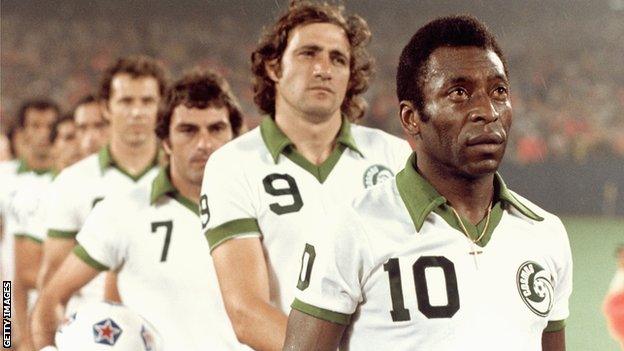
Pele was later joined by Franz Beckenbauer (fourth in line), with striker Giorgio Chinaglia (number nine) also crucial to success
Clive Toye eventually got his man in a motel outside Brussels airport.
After a four-year pursuit, Pele put pen to a sheet of hotel notepaper to become the highest-paid athlete on the planet.
When the world's greatest footballer touched down in New York in 1975, the team he joined was a rabble of students and semi-professionals playing on dirt fields littered with shards of glass.
By the time the New York Cosmos won the 1977 Soccer Bowl - in Brazil forward Pele's last competitive game - they boasted World Cup winners and record crowds, partied with celebrities and lunched with presidents.
Backed by media mogul Steve Ross' Warner Communications, owners of Warner Bros and Atlantic Records, the Galacticos in the Big Apple were treated like rock stars and behaved like them too.
It was a champagne era that saw the franchise, like American soccer, go from boom to bust within a decade.
The Cosmos, as one former PR guru put it, were one huge aphrodisiac. Now, a new chapter in their story is about to begin.

It was always going to take something special to bring the North American Soccer League (NASL) into the spotlight. Viewing figures were so bad after its debut 1967 season that CBS cancelled its TV deal. The Cosmos, founded in 1970, were far from a household name. Their most significant media exposure was when goalkeeper Shep Messing posed naked in Viva magazine.
"The state of soccer in the US in the 1960s and 70s was quite pathetic," Toye, former general manager at the Cosmos, told the BBC World Service in 2015.
"No-one was interested and no-one knew what soccer was. The only player in the entire universe average Americans had heard of was the fella in Brazil."
Witness: Pele joins New York Cosmos
Toye, the New York Cosmos and the NASL all needed Pele.
A former Daily Express sports writer, Toye had first met the Santos forward in 1971, fresh from his third World Cup win with Brazil the previous summer. Three years later, and with Pele having hung up his boots, he sensed an opportunity.
Juventus and Real Madrid were attempting to lure the superstar out of retirement, but the Englishman's unique sales pitch piqued Pele's interest.
"I said 'OK, if you go there you can win a championship. If you come with us you can win a country'," he recalled.
Toye chased Pele via Jamaica, Frankfurt, Brussels and Rome. They lunched in Guaruja and held more meetings in Rio and Sao Paulo. Finally the 34-year-old football legend passed a medical and signed up to a three-year package that included marketing, PR rights and a music contract worth a reported total of $4m (roughly $20m in today's terms).
The deal was nudged over the line by US secretary of state Henry Kissinger, who sent a telegram saying the striker's arrival would "substantially contribute to closer ties between Brazil and the United States in the field of sports", with a similar call coming from Brazil's foreign minister.
On 10 June 1975, Pele was unveiled as a Cosmos player at Manhattan's iconic 21 Club.
Football, or soccer, barely got a mention in the media at the time. The Cosmos' first title in 1972 had hardly made a splash. Now there were hundreds of reporters bundled into the news conference for a glimpse of a star.
"You can spread the news around the world that soccer arrived finally in the USA," proclaimed 'the King', two hours late for his own unveiling.
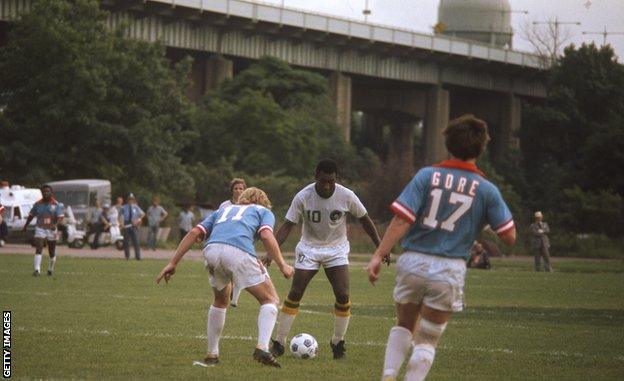
Pele's two years with the Cosmos first brought the football legend to New York's modest Downing Stadium
Pele scored on his debut, a 2-2 draw in a friendly against Dallas Tornado on 15 June 1975. A capacity crowd of 21,000 fans watched at Downing Stadium, the Cosmos' home ground on Randall's Island, where the threadbare pitch was spray painted green for the television cameras.
Five days later, Pele and the Cosmos went to Boston. Almost double Nickerson Field's 12,000-capacity crammed into the college stadium. Spectators huddled along the touchline and behind the goals to witness the Brazilian face Portugal great Eusebio, who had signed for Boston on loan.
With 11 minutes remaining, fans rushed on to the artificial pitch to mob Pele. "They swarmed him, burying him for several minutes," wrote John Powers of the Boston Globe.
The Cosmos star had to be rescued by his personal bodyguard and taken away on a stretcher. Soccer mania had landed in the United States.
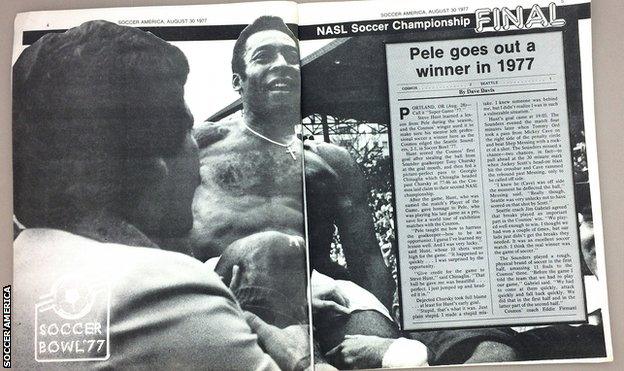
The 1977 Soccer Bowl was Pele's final competitive appearance
New York was dubbed 'Cosmos Country', and although Pele's arrival was not enough to help the franchise reach the 1975 play-offs, record crowds would turn out to watch him play in different cities.
For Warner chief Ross, it was a marketing dream. Pele was pictured having a kickabout at the White House with President Gerald Ford, the globe-trotting Cosmos went on two exhibition tours in seven months and the players were treated to five-star travel, all expenses paid.
The knock-on effect was the arrival of stars at other franchises - George Best joined the LA Aztecs, part-owned by Elton John, Geoff Hurst moved to the Seattle Sounders and Rodney Marsh was snapped up by the Tampa Bay Rowdies.
When introduced as 'the white Pele', Marsh jokingly responded: "No, Pele is known as the black Rodney Marsh." It earned him a kick from the Brazilian during their first meeting.
Flamboyant Englishman Marsh and his Tampa team-mates had another trick up their sleeve to keep Pele and strike partner Giorgio Chinaglia quiet when they met again in the 1976 Conference semi-finals.
"We had a limo that met them off the plane with two girls in and two bottles of Chivas Regal," he told the documentary 'Once in a Lifetime: The Incredible Story of the New York Cosmos'.
"Twenty-four hours later they both came on to the pitch looking very much worse for wear."
Tampa won 3-1. But that first taste of real success wasn't far away.

The offer came out of the blue. Steve Hunt walked into training at Aston Villa in November 1976 and was told the club had accepted a bid for him.
Hunt, then aged 20, had never even heard of the Cosmos. When he found out he'd be doing pre-season training with Pele in Bermuda, he took all of 10 seconds to agree.
"It sounds a bit of a fairytale now," Hunt tells BBC Sport. "I was probably going to play against Preston reserves that weekend and I ended up flying to Bermuda."
The winger, who'd only got married a month earlier, next faced away games in Hawaii and Las Vegas. As the homesickness wore off he settled in New Jersey, away from the hustle and bustle of Manhattan, mixing more with the Cosmos' other British and American players.
"I was surprised by the standard," he says. "I came to understand the brand of the Cosmos and how global it was."
The franchise, playing in shirts designed by Ralph Lauren, moved into the 80,000-seat, newly opened Giants Stadium for the 1977 season. It was a fully Americanised experience - Bugs Bunny as mascot, half-time bands and the Cosmos Girls cheerleading squad.
Warner supremo Ross would host an endless list of celebrities: Barbara Streisand, Robert Redford and Steven Spielberg were all there. Cosmos games became a paparazzi dream.
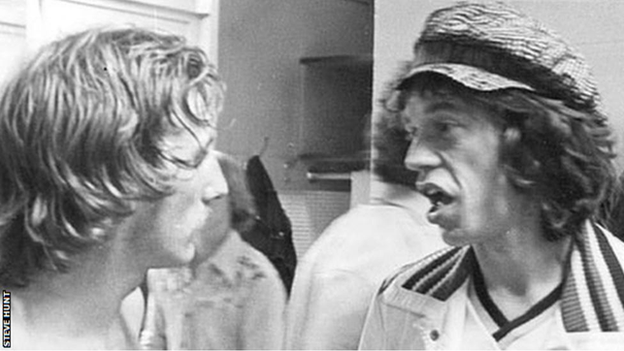
Steve Hunt and Mick Jagger, pictured in the Cosmos dressing room
"I've always likened it to being a rock 'n' roll football team," says Hunt, whose highlights include being introduced to Rolling Stones frontman Mick Jagger and witnessing the iconic meeting of Pele and Muhammad Ali.
"The doors would open in the changing rooms 10 minutes after a game and all of a sudden an entourage would come in and you never knew who you were going to see.
"I heard someone shout: 'Where's the Englishman?' I looked round and could see this guy in a hat. Jagger. He'd asked to speak to me, it was immense - he congratulated me on the game and all I wanted to talk about was rock 'n' roll!"
The squad's main hangout was world-famous celebrity haunt Studio 54, but life was just as manic on the road. Club secretary Steve Marshall likened Cosmos away trips to touring with the Stones, while PR guru James Trecker claimed some of the travelling party enjoyed a culture of sex, drugs and alcohol.
"It was a team that knew how to party, knew where to party and knew with whom to party," he told 'Once in a Lifetime'. "There were groupies at the hotel, groupies in the lobby, groupies in the stadium."
It's a tale disputed by some ex-players in the book 'Rock 'n' Roll Soccer'. Bob Iarusci called the film nonsense, while Charlie Mitchell says he was unaware "we could apparently walk into any nightclub in New York" like the Jets, Giants or Yankees.
After a stuttering start to the 1977 season, the stars aligned for the Cosmos, who invested in a pair of World Cup winners - Brazil captain Carlos Alberto and Germany legend Franz Beckenbauer.
"Beckenbauer and Carlos Alberto just took us to another level," remembers Hunt.
"It wasn't just the football side of it, it was how they conducted themselves and had time for people. I enjoyed their company as much as I enjoyed playing with them.
"Beckenbauer had this elegance about him, very smooth moving and that's how he is off the pitch, just a nice guy, one of the team."
But it was a fiery, larger-than-life former Italy international who grew up in Cardiff that made the Cosmos tick.
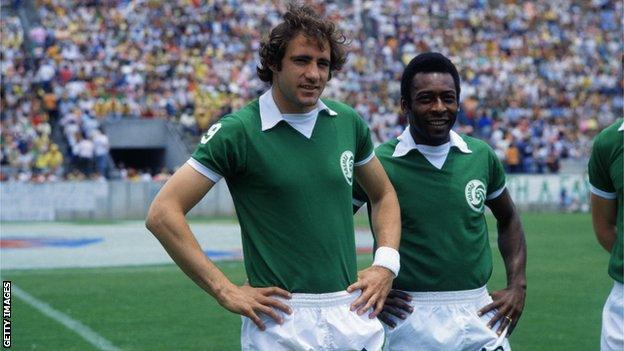
Chinaglia, who started his career at Swansea, died in April 2012 at the age of 65
Giorgio Chinaglia was as prolific as he was problematic. He scored 193 goals in 213 games for the Cosmos, making him the NASL's all-time leading scorer. He got into almost as many scuffles with his team-mates.
"I had a fight with him within a month," laughs Hunt. "I called him lazy so he smacked me one and we had a go at it.
"You're playing with these people so you have to put it right - we had a chat and it was decided I was there to provide him with chances to score. I obliged, so we got on fine."
There was a notorious changing-room bust up with Pele, with Chinaglia reportedly bringing him to tears after insisting the Brazilian pass more often.
"Giorgio is a brilliant player," Beckenbauer told the New York Times. "But he has no career as a diplomat."
Hunt says Chinaglia "spoke his mind and didn't mind upsetting people", adding: "But he was the best goalscorer I ever played with by far. His ratio of shots to goals was ridiculous. He was exceptionally good."
While Pele was chased around the world, Chinaglia's signing was almost the exact opposite.
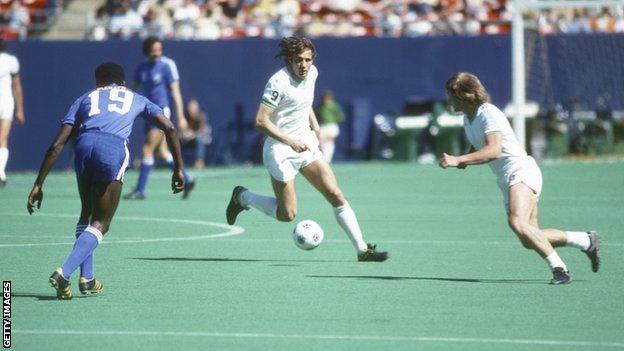
Chinaglia, pictured in 1977 at the Giants Stadium. He played for the Cosmos until 1985
Born in Tuscany, Chinaglia moved to Cardiff with his family when he was a boy and he began his career at Swansea, before returning to Italy for military service and eventually signing for Lazio.
By the time he stormed into Clive Toye's office while on holiday in the States in 1975, Chinaglia had fired Lazio to the Serie A title as the division's leading goalscorer and won 14 international caps.
According to Toye, the Italian, whose wife Connie was American, said he wanted to sign for the Cosmos or would simply buy his own franchise.
He quickly left his mark. He was adored by Cosmos owner Ross, accompanying him to Frank Sinatra's birthday party, but not boss Gordon Bradley, who was sacked during the '77 season with Chinaglia influential in appointing his successor. Toye, another to clash with the brash striker, also departed.
"Sometimes I wasn't liked, but I don't care about that. If you don't have egos in life, especially in sport, you're not going to go very far," said Chinaglia, who commissioned two portraits of himself by American impressionist LeRoy Neiman as if to emphasise that point. In one he is putting on a silk dressing gown in the Cosmos changing room.
In the 1977 regular season, Chinaglia scored 15 times to help the Cosmos reach the play-offs.
He scored another, and Pele two, in a 3-0 win over Tampa Bay, before putting a hat-trick past Gordon Banks in an 8-3 win over the Fort Lauderdale Strikers in front of a NASL-record 77,691 fans at Giants Stadium.
His total of nine goals in the play-offs, alongside five for Pele and four for Hunt, saw the Cosmos reach the Soccer Bowl, where they would face the Seattle Sounders in Portland in what would be Pele's final professional match, on 28 August 1977.
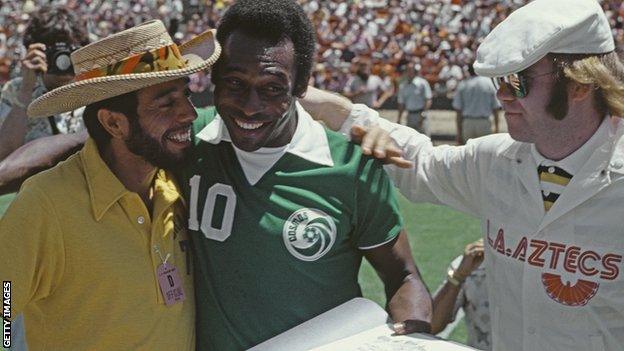
Pele, pictured with Brazilian musician Sergio Mendes and Elton John in Los Angeles, before a fixture with the LA Aztecs in July 1977
"That season was all about Pele," says Hunt. "I had to prove myself because I was just a new kid from Birmingham, England and they didn't know me. I had a task on my hands to establish myself over there.
"We wanted to do well and when we got to the final that was the motivation - for Pele to go out on a high."
That new boy from Birmingham certainly played his part in a performance that earned him the Soccer Bowl's Most Valuable Player award.
The long-haired winger nabbed the ball from Seattle goalkeeper Tony Chursky to poke into an empty net for the opener and was hoisted into the air by Pele and Chinaglia in celebration.
English forward Tommy Ord levelled soon after but, in the 81st minute, Hunt received a pass from Pele on the left, whipped in a cross and the ruthless Chinaglia headed the winner.
"Give credit for the game to Steve Hunt," Chinaglia told the press afterwards. "That ball he gave me was beautiful. I just jumped up and headed it in."
As the champagne flowed in the dressing room, Pele was sought out by reporters.

Without Pele, the Cosmos would go on to claim another three Soccer Bowl titles
"After three World Cups, now this," he said. "I can stop now, as a champion, I can die now. I have everything I wanted from my life in soccer."
One month later, following a two-week tour of Japan and China, Pele played his final game, a testimonial broadcast around the world against the only other club he'd ever represented, Santos.
He played one half for each team as the rain fell over Giants Stadium, leading a Brazilian newspaper to report: "Even the sky was crying."
This time, football's most iconic figure had retired for good. He was about to turn 37.
Time would soon be up for the NASL too, despite its tender years.

Without Pele, the Cosmos returned to win the Soccer Bowl the next season in 1978. They won it again in 1980 and then once more in 1982 to make it four championships from six seasons.
"It was an adventure," Beckenbauer told 'Once in a Lifetime'. "It was like an explosion. It was like a family, it was fantastic, an experience I will never forget."
Hunt joined Coventry City after the '78 success - not before playing alongside Johan Cruyff when the Netherlands great joined the Cosmos for an exhibition game - but returned on loan for the 1982 season.
"I was disappointed," says Hunt. "Franchises had folded, new ones were starting up and hanging on."
The Cosmos still boasted stars in Chinaglia and Dutch legend Johan Neeskens but attendances had begun to dwindle. The NASL was in sharp decline.
Over-expansion, mismanagement and teams spending lavish sums in an effort to keep up with the Cosmos began to bite. Most franchises were haemorrhaging cash.
The Cosmos had always been a vanity project for Ross and in 1984, after Warner's finances were hit by the crash of Atari, a video games console company they had invested in, he handed majority ownership to Chinaglia.
That year, the league collapsed. The Cosmos continued to play in the Major Indoor Soccer League but withdrew in February 1985. By June, the dream was officially over.
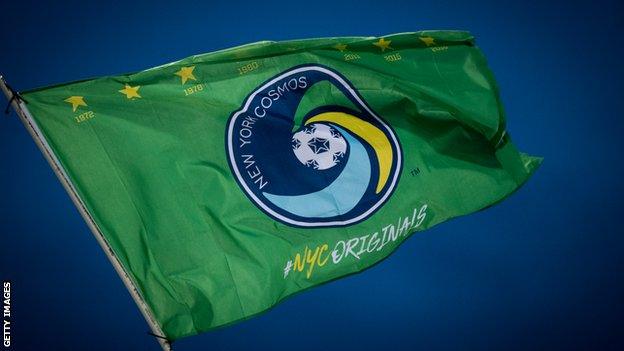
Having survived a second NASL collapse, the Cosmos are back in business in 2020
However, fast forward 35 years and, after several false dawns - including a legal battle with Eric Cantona - the New York Cosmos have been revived.
A long way from the glamour of their predecessors, the club are scheduled to play in the US third-tier equivalent National Independent Soccer Association, external in August.
It is a decade since Pele first announced the Cosmos would return and harboured ambitions to play in Major League Soccer (MLS). The club never ceased to exist entirely, lingering away from the spotlight with their series of youth camps.
They eventually made a successful return to the professional game in the reformed second-tier North American Soccer League in 2013, luring former Spain star Raul, winning three league titles and hiring Cantona as the club's director of soccer - though the Frenchman was sacked after punching a photographer in 2014 and sued the club over unpaid wages.
Various obstacles meant a move to the MLS never happened, and it was a case of deja vu for the NASL.
The league disbanded following the 2017 season, leaving the Cosmos 'on hiatus'. That is until now, having joined the NISA for the competition's 2020 Fall Season.
It will be modest re-beginnings for a club once idolised around the globe and the prospect of competing in the MLS remains distant, with the organisation reluctant to add a third New York franchise - after New York Red Bulls and New York City FC - to their roster.
But the Cosmos brand, and the legend, lives on., external

Louis Theroux: Eight things we learned when he spoke to Joe Wicks
6 Degrees from...Thierry Henry: Six calls to track down the football legend
